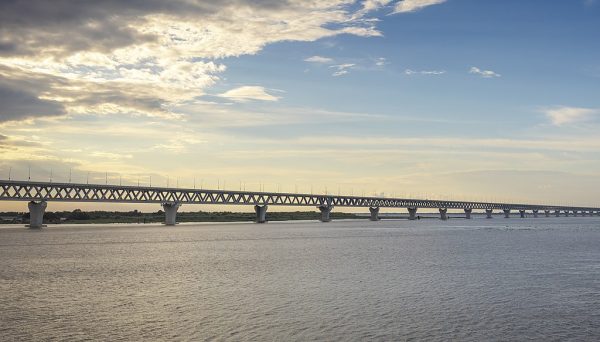On June 25, Prime Minister Sheikh Hasina inaugurated a bridge over the Padma River. The longest bridge in Bangladesh, the 6.15-km-long Padma Multipurpose Bridge marks an important milestone in independent Bangladesh’s history, as it is a symbol not just of Bangladesh’s resolve but of its growing economic capacity and development.
Speaking at the inauguration of the Padma Bridge, Hasina said: “This bridge is not just bricks, cement, iron, and concrete This bridge is our pride, a symbol of our capacity, our strength and our dignity. This bridge belongs to the people of Bangladesh.”
The Hasina government’s original plan was to build the Padma Bridge with external funding from the World Bank, Asian Development Bank (ADB), and the Japan International Cooperation Agency (JICA). However the World Bank suddenly withdrew from funding the project in 2012, citing corruption of government officials. This result in other funders pulling out of the project too. It seriously impacted the image of the country and of the ruling party, the Awami League. It was a setback for the people of Bangladesh as well. This prompted Hasina to opt for self-funding the project despite economists and opposition politicians warning against it. So the completion of the Padma Bridge has become a symbol of national pride and dignity.
Constructed at a cost of nearly $3.87 billion, the Padma Bridge is one of the largest projects Bangladesh has ever undertaken. It connects 21 districts in southwest Bangladesh with the capital, Dhaka, by road and rail and cuts travel time substantially.
While the global economic situation is gloomy and countries in the region are experiencing negative growth, Bangladesh’s economy is growing. The Global Economic Forum says that Bangladesh’s per capita income, which was $2,260 in 2020, will rise to $2,860 in 2025. Apart from this project, Bangladesh has also extended support to Maldives and Sri Lanka by providing them with loans worth $400 million. Bangladesh’s funding of the mega Padma project will now add to its reputation as a rising economic power in South Asia.
Awami League leaders credit Hasina’s strong leadership over the past 13 years for Bangladesh’s emergence as a middle income country and its other economic successes.
The Padma Bridge’s biggest contribution will be to Bangladesh’s economic growth. Economists say that it will provide a 1.3 to 2 percent boost per annum to the country’s GDP. When the railway component of the bridge is completed, the project will contribute another 1 percent to the GDP. The bridge project’s contribution to Bangladesh’s GDP is expected to rise to 5 percent by 2055.
According to Zahid Hossain, a lead economist of the World Bank, the Padma Bridge will cut travel distance by 100 km for around 27 percent of Bangladesh’s population to boost business and agriculture, thereby impacting the country’s GDP.
Other experts confirm that the bridge will help alleviate poverty, boost trade, tourism, and industry, and create opportunities for employment in the southwest of the country.
The Padma Bridge has regional implications as well.
It will improve connectivity. Bangladesh, Bhutan, India, and Nepal signed a Motor Vehicle Agreement for the Regulation of Passenger, Personal and Cargo Vehicular Traffic in 2015. The Padma Bridge will provide the BBIN Network with the connectivity it needs.
For cargo from its Northeast headed to Kolkata, India has long been eyeing a shorter transit route through Bangladesh. During his visit to Bangladesh in April 2022, India’s Minister for External Affairs S. Jaishankar said, “India looks forward to a stronger subregional cooperation in connectivity.” In a statement issued on the inauguration of the Padma Bridge, the Indian High Commission in Dhaka said that the bridge “would not only help improve intra-Bangladesh connectivity, but it will also provide much-needed impetus to logistics and businesses connecting India and our shared subregion… The bridge will play an important role in fostering greater bilateral and subregional connectivity.”
The Padma Bridge is expected to impact domestic politics too. Given the mass irregularities in the conduct of the general elections in 2014 and 2018, the current Awami League government has lacked legitimacy in the eyes of several countries, including the United States. While the Hasina government is under tremendous pressure to ensure a free and fair election when it is held in 2023, a development project of the magnitude and significance of the Padma project will bestow the government with legitimacy from below.
With questions being raised over the legitimacy of elections and the quality of Bangladesh’s democracy, Awami League leaders have been promoting the idea of “Less Democracy, More Development” in the parliament. They will be able to hold the Padma project as a shining example of that development.
Even as northeast Bangladesh was reeling under its worst flood in decades, the Hasina government celebrated the inauguration of the Padma Bridge across the country and spent a considerable amount of money on this. Clearly, the government wants to draw electoral benefit from the completion of the bridge. Only time will tell whether the Padma Bridge will serve the Awami League’s political and electoral agenda or not.


